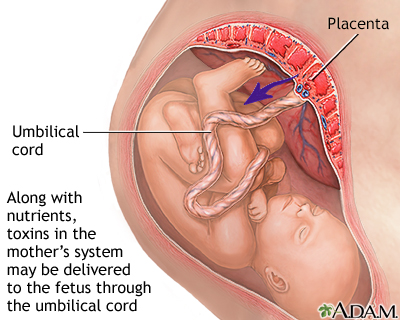Infant of a substance-using mother
IUDE; Intrauterine drug exposure; Maternal drug abuse; Maternal substance use; Maternal drug use; Narcotic exposure - infant; Substance use disorder - infant
Images

I Would Like to Learn About:
Information
Maternal substance use may consist of any combination of drug, chemical, alcohol, and tobacco use during the pregnancy.
While in the womb (uterus), a fetus grows and develops due to nourishment from the mother via the placenta. However, along with nutrients, any toxins in the mother's system may be delivered to the fetus. These toxins may cause damage to the developing fetal organs. A baby also may become dependent on substances used by the mother.
WHAT ARE THE SIGNS AND SYMPTOMS SEEN IN AN INFANT OF A SUBSTANCE-USING MOTHER?
Babies born to substance-using mothers may have short- or long-term effects.
- Short-term withdrawal symptoms may consist only of mild fussiness.
- More severe symptoms may include irritable or jittery behavior, feeding problems, and diarrhea. Symptoms vary depending on which substances were used.
- The diagnosis for babies with signs of withdrawal may be confirmed with drug tests of the baby's urine, stool or umbilical cord. The mother's urine may also be tested. However, if urine or stool is not collected soon enough, the results may be negative.
More significant long-term developmental problems may be seen in babies who are born with growth failure or various organ problems.
- Infants born to mothers who drink alcohol, even in modest amounts, are at risk for fetal alcohol syndrome (FAS). This condition consists of growth problems, unusual facial features, and intellectual disability. It may not be detected at the time of birth.
- Other drugs may cause birth defects involving the heart, brain, bowel, or kidneys.
- Babies who have been exposed to drugs, alcohol, or tobacco are at higher risk for SIDS (sudden infant death syndrome).
WHAT IS THE TREATMENT FOR AN INFANT OF A SUBSTANCE-USING MOTHER?
The baby's treatment will depend on the drugs the mother used. Treatment may involve:
- Limiting noise and bright lights
- Maximizing "TLC" (tender loving care) including skin-to-skin care and breastfeeding with mothers who are in treatment/no longer using illicit substances
- Using medicines (in some cases)
In the case of babies whose mothers used narcotics, the baby may require small doses of a narcotic. The amount is slowly adjusted as the baby is weaned off of the substance over days to weeks. Sedatives are sometimes used as well.
Infants with organ damage, birth defects or developmental issues may need medical or surgical therapy and long-term therapies.
These infants are more likely to grow up in homes that do not promote healthy emotional, social, and mental development. They and their families will benefit from long-term support.
References
Baer GR, Singh R, Davis JR. Intrauterine drug exposure: fetal and postnatal effects. In: Gleason CA, Sawyer T, eds. Avery's Diseases of the Newborn.11th ed. Philadelphia, PA: Elsevier; 2024:chap 11.
Hudak M. Infants of substance-using mothers. In: Martin RM, Fanaroff AA, eds. Fanaroff and Martin's Neonatal-Perinatal Medicine. 12th ed. Philadelphia, PA: Elsevier; 2025:chap 48.
Kliegman RM, St. Geme JW, Blum NJ, Shah SS, Tasker RC, Wilson KM. Abstinence syndromes. In Kliegman RM, St. Geme JW, Blum NJ, Shah SS, Tasker RC, Wilson KM, eds. Nelson Textbook of Pediatrics. 21st ed. Philadelphia, PA: Elsevier; 2020:chap 126.
BACK TO TOPReview Date: 12/31/2023
Reviewed By: Mary J. Terrell, MD, IBCLC, Neonatologist, Cape Fear Valley Medical Center, Fayetteville, NC. Review provided by VeriMed Healthcare Network. Also reviewed by David C. Dugdale, MD, Medical Director, Brenda Conaway, Editorial Director, and the A.D.A.M. Editorial team.

Health Content Provider
06/01/2025
|
A.D.A.M., Inc. is accredited by URAC, for Health Content Provider (www.urac.org). URAC's accreditation program is an independent audit to verify that A.D.A.M. follows rigorous standards of quality and accountability. A.D.A.M. is among the first to achieve this important distinction for online health information and services. Learn more about A.D.A.M.'s editorial policy, editorial process and privacy policy. A.D.A.M. is also a founding member of Hi-Ethics. This site complied with the HONcode standard for trustworthy health information from 1995 to 2022, after which HON (Health On the Net, a not-for-profit organization that promoted transparent and reliable health information online) was discontinued. |
The information provided herein should not be used during any medical emergency or for the diagnosis or treatment of any medical condition. A licensed medical professional should be consulted for diagnosis and treatment of any and all medical conditions. Links to other sites are provided for information only -- they do not constitute endorsements of those other sites. © 1997- 2024 A.D.A.M., a business unit of Ebix, Inc. Any duplication or distribution of the information contained herein is strictly prohibited.
